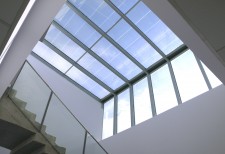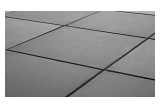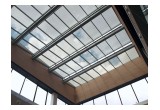Skyco Skylights Manufactures Innovative, Green Building Integrated Photovoltaic Systems

Costa Mesa, CA, September 21, 2016 (Newswire.com) - The vast majority of these solar projects are referred to as Building Applied Photovoltaics. We see them popping up everywhere, the obstructive black panels sitting on tile roofs facing as south as possible. Take that concept one step further and you get Building Integrated Photovoltaic or BIPV, and Costa Mesa manufacturer SKYCO Skylights is making it their mission to bring more viability to these hidden power gems.
We all understand the term Integrated, and BIPV is just that, solar power technology integrated into the building itself. For example, in July Apple unveiled their newest flagship store in Union Square. To the lay person walking the roof they would think they are walking on normal roofing tiles. SKYCO Skylights was able to integrate the roofing structure with photovoltaic tiles. These tiles are so strong, Apple could feasibly land a helicopter on the roof without blemishing the solar tiles.
We see a lot of applications for the photovoltaic glass, skylights being one of them. The technology has been around for some time now, but with power rates and incentives it is now a serious option for saving money.
Paul Simony, VP of Sales at SKYCO Skylights
Another interesting concept, and most applicable, are solar skylights. The glass in a skylight is designed to collect anywhere from 30-70% of the sunlight for energy generation, the remainder of sunlight not converted to power is visible light passing through the skylight. You may have walked under a BIPV system without knowing it. They look and act just like a tinted skylight.
By swapping traditional glass with photovoltaic glass, building owners are able to capitalize on the 30% federal credits (plus various State credits). In the end, the net investment is equal or less than the investment in a traditional skylight, except BIPV skylights will generate power thus adding to ROI.
“With the tax incentives and power consumption savings, it really begs the question why would anyone put in a traditional system instead of a photovoltaic skylight,” comments Paul Simony, VP of Sales at SKYCO Skylights and industry leading consultant on building integrated photovoltaics. “We see a lot of applications for the photovoltaic glass, skylights being one of them. The technology has been around for some time now, but with power rates and incentives it is now a serious option for saving money.”
There are several reasons why brands like Apple are adopting this technology. Apple has committed to building all its new retail stores with 100% renewable energy. The challenge for them is maintaining the architectural aesthetics we’ve all come to expect in an Apple building. BIPV helps them achieved their power goals while enhancing the building’s appearance. The brand-ability behind this innovative technology is a plus.
Manufacturers like SKYCO Skylights have invested significant time and resources to develop and finely tune BIPV systems. Finally, building owners have another option instead of the cumbersome black solar panels popping up on roofs.
Source: SkyCo Skylights



